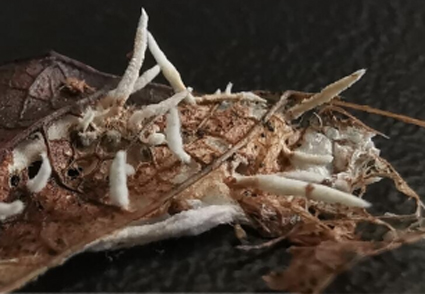Abstract
A new species, Ovicillium sinense, which was isolated from an infected pupa, is introduced. Morphological comparisons with extant species and DNA-based phylogenies from analysis of a multigene dataset of combined ITS, LSU and TEF sequence data support the establishment of the new species. It differs from other species by its phialides that are attenuated from the middle to the apex, the conidia aggregated in large globose to subglobose heads, and having shorter phialides and smaller conidia.
References
- Castlebury, L.A., Rossman, A.Y., Sung, G.H., Hyten, A.S. & Spatafora, J.W. (2004) Multigene phylogeny reveals new lineage for Stachybotrys chartarum, the indoor air fungus. Mycological Research 108: 864–872. https://doi.org/10.1017/S0953756204000607
- Chen, W.H., Liu, C., Han, Y.F., Liang, J.D., Tian, W.Y. & Liang, Z.Q. (2019) Three novel insect-associated species of Simplicillium (Cordycipitaceae, Hypocreales) from Southwest China. MycoKeys 58: 83–102. https://doi.org/10.3897/mycokeys.58.37176
- Chen, W., Liang, J., Ren, X., Zhao, J., Han, Y. & Liang, Z. (2021) Cryptic diversity of isaria-like species in Guizhou, China. Life (Basel, Switzerland) 11 (10): 1093. https://doi.org/10.3390/life11101093
- Drummond, A. & Rambaut, A. (2007) BEAST: Bayesian evolutionary analysis by sampling trees. BMC Evolutionary Biology 7: e214. https://doi.org/10.1186/1471-2148-7-214
- Hou, L.W., Groenewald, J.Z., Rama, T., Summerbell, R.C., Huang, G.Z., Cai, L. & Crous, P.W. (2023) Redisposition of acremonium-like fungi in Hypocreales. Studies in Mycology 105: 100–180. https://doi.org/10.3114/sim.2023.105.02
- Kalyaanamoorthy, S., Minh, B.Q., Wong, T.K., von Haeseler, A. & Jermiin, L.S. (2017) ModelFinder: fast model selection for accurate phylogenetic estimates. Nature Methods 14: 587–589. https://doi.org/10.1038/nmeth.4285.
- Katoh, K. & Standley, D.M. (2013) MAFFT multiple sequence alignment software version 7: improvements in performance and usability. Molecular Biology and Evolution 30 (4): 772–780. https://doi.org/10.1093/molbev/mst010
- Liang, J.D., Han, Y.F., Zhang, J.W., Du, W., Liang, Z.Q. & Li, Z.Z. (2011) Optimal culture conditions for keratinase production by a novel thermophilic Myceliophthora thermophila strain GZUIFR-H49-1. Journal of Applied Microbiology 110: 871–880. https://doi.org/10.1111/j.1365-2672.2011.04949.x
- Ronquist, F., Teslenko, M., van der Mark, P., Ayres, D.L., Darling, A., Höhna, S., Larget, B., Liu, L., Suchard, M.A. & Huelsenbeck, J.P. (2012) MrBayes 3.2: efficient Bayesian phylogenetic inference and model choice across a large model space. Systematic Biology 61: 539–542. https://doi.org/10.1093/sysbio/sys029
- Tamura, K., Stecher, G., Peterson, D., Filipski, A. & Kumar, S. (2013) MEGA6: molecular evolutionary genetics analysis version 6.0. Molecular Biology and Evolution 30: 2725–2729. https://doi.org/10.1093/molbev/mst197
- Trifinopoulos, J., Nguyen, L.T., von Haeseler, A. & Minh, B.Q. (2016) W-IQ-TREE: a fast online phylogenetic tool for maximum likelihood analysis. Nucleic Acids Research 44 (W1): W232–W235. https://doi.org/10.1093/nar/gkw256
- Vaidya, G., Lohman, D.J. & Meier, R. (2011) SequenceMatrix: concatenation software for the fast assembly of multi-gene datasets with character set and codon information. Cladistics 27 (2): 171–180. https://doi.org/10.1111/j.1096-0031.2010.00329.x
- Vilgalys, R. & Hester, M. (1990) Rapid genetic identification and mapping of enzymatically amplified ribosomal DNA from several Cryptococcus species. Journal of Bacteriology 172 (8): 4238–4246. https://doi.org/10.1128/jb.172.8.4238-4246.1990
- White, T.J., Bruns, T., Lee, S. & Taylor, J. (1990) Amplification and direct sequencing of fungal ribosomal RNA genes for phylogenetics. In: Innis, M.A., Gelfand, D.H., Sninsky, J.J. & White, T.J. (Eds.) PCR protocols: a guide to methods and applications. Academic Press, New York, pp. 315–322. https://doi.org/10.1016/B978-0-12-372180-8.50042-1
- Zare, R. & Gams, W. (2016). More white verticillium-like anamorphs with erect conidiophores. Mycological Progress 15 (10): 993–1030. https://doi.org/10.1007/s11557-016-1214-8
- Zhang, D., Gao, F., Jakovlic, I., Zou, H., Zhang, J., Li, W.X. & Wang, G.T. (2020) PhyloSuite: an integrated and scalable desktop platform for streamlined molecular sequence data management and evolutionary phylogenetics studies. Molecular Ecology Resources 20: 348–355. https://doi.org/10.1111/1755-0998.13096
- Zou, X., Liu, A.Y., Liang, Z.Q., Han, Y.F. & Yang, M.F. (2010) Hirsutella liboensis, a new entomopathogenic species affecting Cossidae (Lepidoptera) in China. Mycotaxon 111 (1): 39–44. https://doi.org/10.5248/111.39


